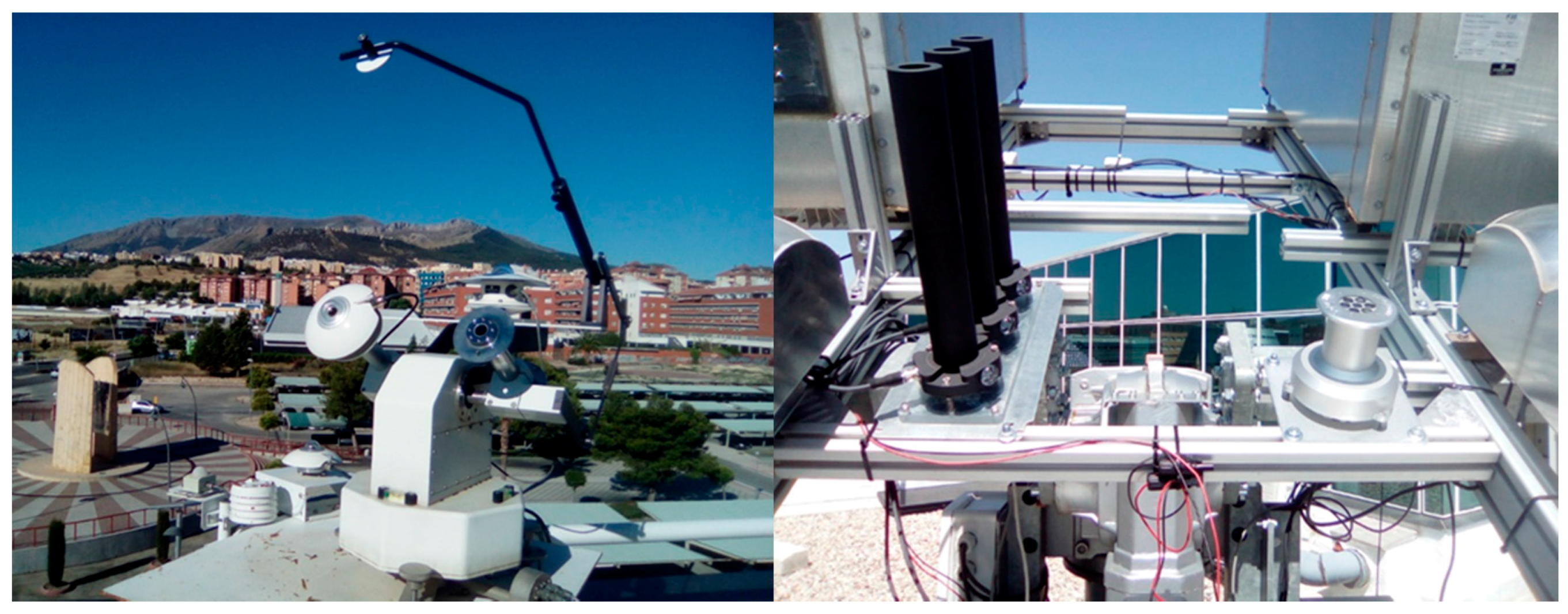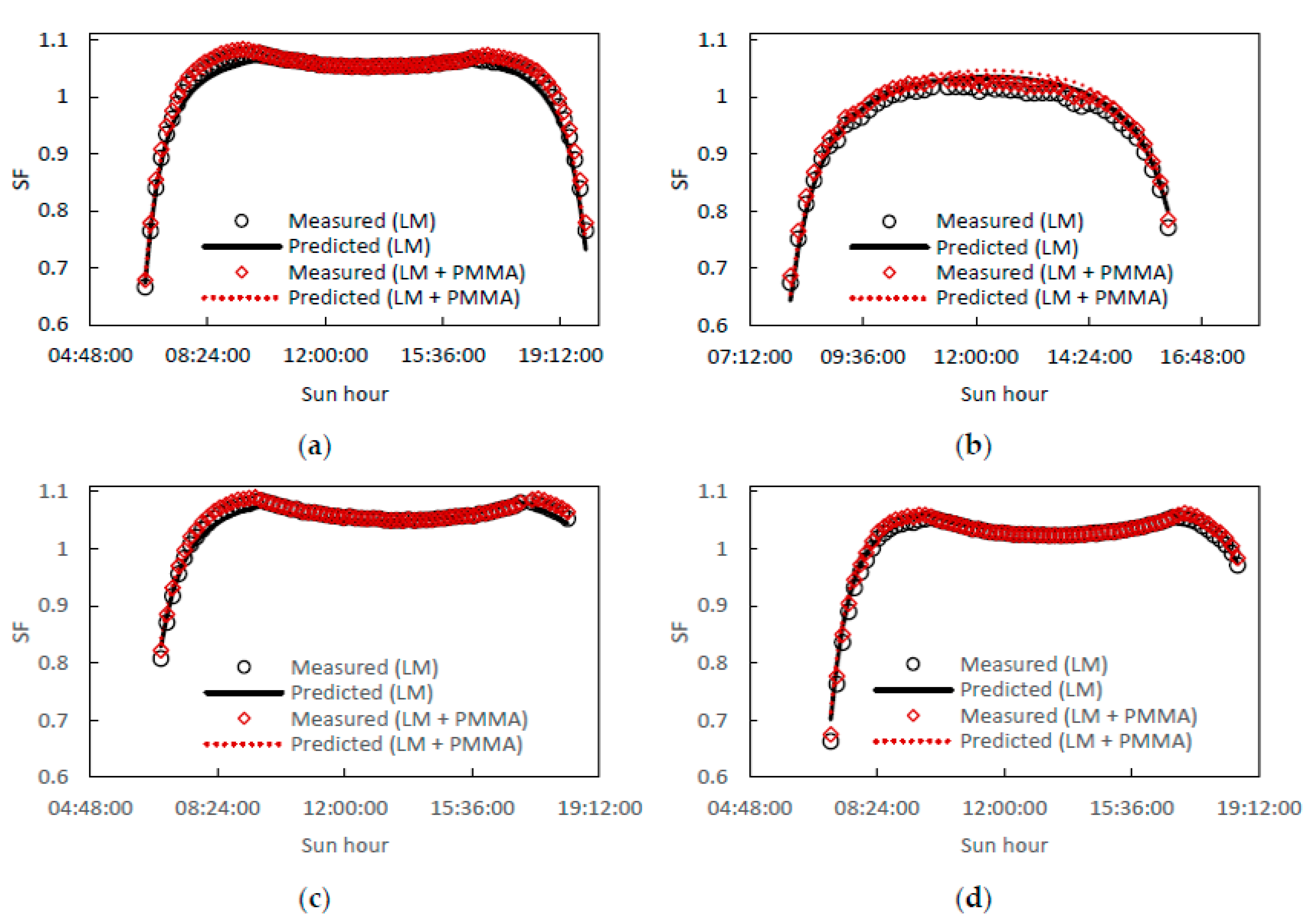Spectral Correction of CPV Modules Equipped with GaInP/GaInAs/Ge Solar Cells and Fresnel Lenses
Abstract
:Featured Application
Abstract
1. Introduction
- Bulk spectral simulations are not required and therefore the procedure is easy to handle;
- The equations can be applied worldwide using ground-based (e.g., the aerosol robotic network, AERONET) or satellite (e.g., the moderate resolution imaging spectroradiometer, MODIS) observations;
- Therefore, relatively expensive measuring equipment that evaluates the solar spectrum is not required, given that a meteorological database is available at the specific site
2. Materials and Methods
2.1. The Spectral Factor in MJ-Based CPV Devices
2.2. Proposed Analytical Equations
- 1 ≤ AM ≤ 5, step 0.25
- 0.05 ≤ AOD ≤ 0.6, step 0.05
- 0.25 ≤ PW ≤ 4 cm, step 0.25 cm
2.3. Experimental Campaign
- LM: a device based on a lattice-matched GaInP/GaInAs/Ge solar cell
- LM + PMMA: a device based on a LM solar cell and a poly(methyl methacrylate) (PMMA) Fresnel lens
- MM: a device based on a metamorphic GaInP/GaInAs/Ge solar cell
- MM + SoG: a device based on a MM solar cell and a silicone-on-glass (SoG) Fresnel lens.
3. Analysis of Results
- 21 June 2016—clear atmosphere with low AM (= 2.0, = 0.06, = 2.34 cm)
- 23 December 2016—clear atmosphere with high AM (= 3.4, = 0.04, = 1.35 cm)
- 29 June 2016—relatively hazy atmosphere (= 2.0, = 0.28, = 2.50 cm)
- 18 August 2016—relatively wet atmosphere ( = 2.1, = 0.12, = 3.62 cm)
4. Summary and Conclusions
Acknowledgments
Author Contributions
Conflicts of Interest
References
- Fthenakis, V. (Ed.) Preface. In Third Generation Photovoltaics; InTech: Rijeka, Croatia, 2012; pp. VII–X. [Google Scholar]
- REN21. Renewables 2015 Global Status Report; REN21: Paris, France, 2015. [Google Scholar]
- Aguilera, J. Introduction. In High Concentrator Photovoltaics; Pérez-Higueras, P., Fernández, E.F., Eds.; Springer International Publishing: Cham, Switzerland, 2015; pp. 1–8. [Google Scholar]
- McConnell, R.; Fthenakis, V. Concentrated Photovoltaics. In Third Generation Photovoltaics; Fthenakis, V., Ed.; InTech: Rijeka, Croatia, 2012; pp. 167–182. [Google Scholar]
- Theristis, M.; O’Donovan, T.S. Electrical-thermal analysis of III–V triple-junction solar cells under variable spectra and ambient temperatures. Sol. Energy 2015, 118, 533–546. [Google Scholar] [CrossRef]
- Dimroth, F. New World Record for Solar Cell Efficiency at 46%; Fraunhofer ISE: Freiburg, Germany, 2014. [Google Scholar]
- Theristis, M.; Fernández, E.F.; Stark, C.; O’Donovan, T.S. A theoretical analysis of the impact of atmospheric parameters on the spectral, electrical and thermal performance of a concentrating III–V triple-junction solar cell. Energy Convers. Manag. 2016, 117, 218–227. [Google Scholar] [CrossRef]
- Fernández, E.F.; Soria-Moya, A.; Almonacid, F.; Aguilera, J. Comparative assessment of the spectral impact on the energy yield of high concentrator and conventional photovoltaic technology. Sol. Energy Mater. Sol. Cells 2016, 147, 185–197. [Google Scholar] [CrossRef]
- Theristis, M.; Fernández, E.F.; Sumner, M.; O’Donovan, T.S. Multiphysics modelling and experimental validation of high concentration photovoltaic modules. Energy Convers. Manag. 2017, 139, 122–134. [Google Scholar] [CrossRef]
- Theristis, M.; Fernández, E.F.; Almonacid, F.; Pérez-Higueras, P. Spectral Corrections Based on Air Mass, Aerosol Optical Depth, and Precipitable Water for CPV Performance Modeling. IEEE J. Photovolt. 2016, 6, 1598–1604. [Google Scholar] [CrossRef]
- Caballero, J.A.; Fernández, E.F.; Nofuentes, G.; Soria-Moya, A.; Almonacid, F.; Pérez-Higueras, P.; Theristis, M.; Georghiou, G.E.; Garcia-Loureiro, A. Analytical transfer equations for the spectral modelling of III-V multi-junction concentrator solar cells. In Proceedings of the 2017 Spanish Conference on Electron Devices (CDE), Barcelona, Spain, 8–10 February 2017; pp. 1–4. [Google Scholar]
- Gueymard, C.A. Simple Model of the Atmospheric Radiative Transfer of Sunshine, Version 2 (SMARTS2): Algorithms Description and Performance Assessment; Florida Solar Energy Center: Cocoa, FL, USA, 1995. [Google Scholar]
- Fernández, E.F.; Almonacid, F.; Soria-Moya, A.; Terrados, J. Experimental analysis of the spectral factor for quantifying the spectral influence on concentrator photovoltaic systems under real operating conditions. Energy 2015, 90, 1878–1886. [Google Scholar] [CrossRef]
- Fernández, E.F.; Almonacid, F.; Ruiz-Arias, J.A.; Soria-Moya, A. Analysis of the spectral variations on the performance of high concentrator photovoltaic modules operating under different real climate conditions. Sol. Energy Mater. Sol. Cells 2014, 127, 179–187. [Google Scholar] [CrossRef]


| SF | f(AM) | f(AOD coeff.) | f(PW coeff.) |
|---|---|---|---|
| top | ax4 + bx3 + cx2 + dx + e * | aln(x) + b * | aln(x) + b * |
| middle | ax2 + bx + c * | Ax + b * | |
| bottom | aln(x) + b * | aln(x) + b * |
| Device | MAPE (%) | MRE (%) |
|---|---|---|
| LM | 0.91 | −0.32 |
| LM + PMMA | 0.92 | −0.32 |
| MM | 0.64 | −0.19 |
| MM + SoG | 0.56 | −0.17 |
© 2017 by the authors. Licensee MDPI, Basel, Switzerland. This article is an open access article distributed under the terms and conditions of the Creative Commons Attribution (CC BY) license (http://creativecommons.org/licenses/by/4.0/).
Share and Cite
Theristis, M.; Fernández, E.F.; Almonacid, F.; Georghiou, G.E. Spectral Correction of CPV Modules Equipped with GaInP/GaInAs/Ge Solar Cells and Fresnel Lenses. Appl. Sci. 2017, 7, 842. https://doi.org/10.3390/app7080842
Theristis M, Fernández EF, Almonacid F, Georghiou GE. Spectral Correction of CPV Modules Equipped with GaInP/GaInAs/Ge Solar Cells and Fresnel Lenses. Applied Sciences. 2017; 7(8):842. https://doi.org/10.3390/app7080842
Chicago/Turabian StyleTheristis, Marios, Eduardo F. Fernández, Florencia Almonacid, and George E. Georghiou. 2017. "Spectral Correction of CPV Modules Equipped with GaInP/GaInAs/Ge Solar Cells and Fresnel Lenses" Applied Sciences 7, no. 8: 842. https://doi.org/10.3390/app7080842





